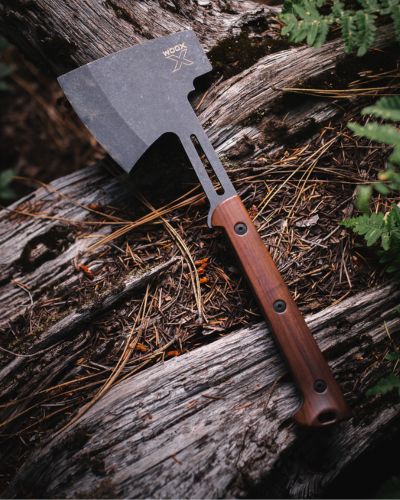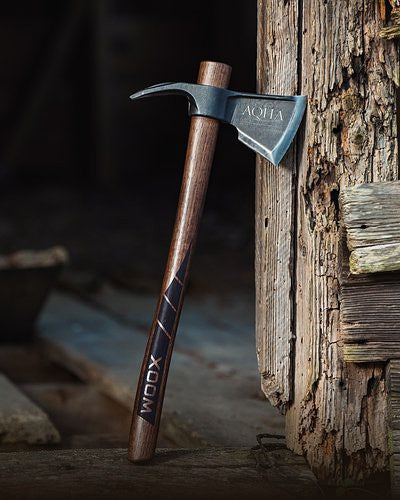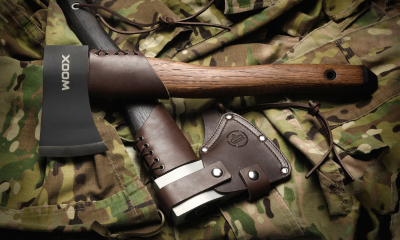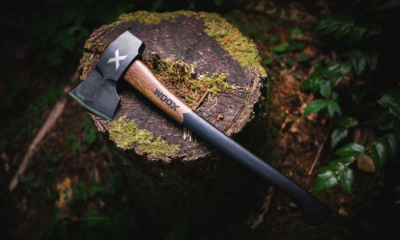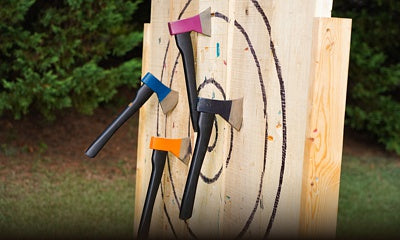
Wood Vs. The World - Pros and Cons of Different Axe Handle Materials
As I’ve said before, the axe is one of Man’s oldest tools. We first held our axes in our hands, but eventually we figured out that an axe head works better when it’s attached to a handle.
For millennia we hung our axe heads on wooden handles, but in recent decades we’ve come up with other materials. Fiberglass, steel (usually with leather or rubber overmold grips), and plastic are popular choices, but in this article, I’ll make the case that the venerable wood axe handle is still the best there is.
FIBERGLASS
Fiberglass axe handles are tough and strong. They are light, and can come in many colors, though yellow and red seem to be the most popular. They are moisture-proof, and variations in temperature and humidity do not cause a fiberglass handle to swell and contract. Fiberglass does not rot.
That inability to rot, however, can also be one of the things against its use. When a fiberglass handle breaks and is thrown away, it will remain a (broken) fiberglass handle. It will not decay- ever. This means that it will stay in the landfill without breaking down pretty much forever.
It’s almost impossible to recycle, so that landfill is the only realistic option for its disposal.
Not only is it not recyclable, as a man-made material fiberglass is not naturally renewable. You can’t just plant more, like you can with trees. Fiberglass is weather resistant, but it is prone to becoming brittle in cold and soft and flexible in the heat.
Fiberglass is durable, but it WILL break… and when it does break, you’ll be hard pressed to replace it. If you’re in the middle of the woods when it breaks, you’re forced to do without an axe- possibly when you need one the most.
Steel
Some companies make their axe handles from steel. They generally come as either steel tubing with a rubber or plastic handle molded to it or as a solid, flat handle forged in one piece with the head. This type usually has a series of stacked leather washers or a rubber overmold as the grip. Steel handles are tough and durable and are not susceptible to the vagaries of the weather.
On the other hand, steel handles are heavy. They transfer the shock of impact to the user’s hand, although there are systems to mitigate this. T
he main drawback to using steel as a handle is that when it eventually breaks (as everything will), you can’t fix it. A bent or broken steel handle is well nigh impossible to replace, particularly they type that is forged as a single piece with the axe’s head.
The grip portion is difficult but not impossible to fix if it’s the stacked leather version, though the difficulty increases if you’re in the field. If the rubber overmold starts peeling though, it’s pretty much done for.
Plastic
Some companies have started using plastic handles for their axes. These are usually made from either polypropylene or fiber reinforced nylon. These kinds of handles are tough. They are dimensionally stable, light, and weather resistant. Some can be replaced with a new handle of the same material.
Plastic, however, transmits shock and vibration very well.
Plastic handles can be slippery when they are wet, and they absolutely become brittle in the cold. While they can be replaced, it isn’t easy to do in the field, unless you happen to be carrying a spare handle with you. Like fiberglass, plastic will remain in a landfill pretty much forever.
WOODEN

And now we come to the traditional wood axe handle. Wood is a renewable resource. It breaks down over time and doesn’t remain in a landfill.
Wood is beautiful, especially when sanded, stained, and rubbed with oil to a polished sheen. Wood axe handles are unaffected by cold or heat, so they don’t become brittle or soft when exposed to temperature extremes. A wood handle can be shaped to exactly fit the user and can be modified to do other things- for instance, my axe handles have marks on them every inch so I can use them to measure things.
And best of all, if a wood handle breaks it can be easily replaced, even in the field. I’ve been forced to carve my own axe handle while on an excursion, and it was a simple process that didn’t require me to cut my trip short.
Wood can be susceptible to changes in humidity that will cause it to shrink or swell, but with proper care and maintenance these effects can be minimal. Rubbing tung oil or boiled linseed oil into your axe handle goes a long way toward preventing this sort of thing.
Hickory Wood Axe Handle
Hickory wood is considered to be one of the best materials for axe handles due to its combination of strength, durability, and flexibility.
One of the most important factors to consider when choosing a wood for an axe handle is strength. Hickory is known for its high strength-to-weight ratio, making it a suitable choice for use in tools such as axes, hammers, and sledgehammers. The wood is able to withstand the heavy impact of chopping and splitting without breaking or splintering.
In addition to its strength, hickory is also known for its durability. The wood is naturally resistant to rot and decay, making it a suitable choice for outdoor use. It is also able to withstand extreme temperatures and weather conditions, which makes it a great option for use in all types of environments.
Flexibilityis also an important factor when choosing a wood for an axe handle. Hickory is known for its ability to bend without breaking, which allows it to absorb the shock of impact. This helps to reduce the amount of vibration and shock felt by the user, making it a more comfortable and ergonomic choice.
Hickory wood is also considered as an eco-friendly option. It is a renewable resource and can be sustainably harvested, it also has a long life-span.
At WOOX, we understand the importance of using high-quality materials in the construction of our tools. That's why we use only premium quality hickory wood for our axe handles.
Our hickory wood comes from mature trees that have grown for at least 30-40 years, this ensures that the wood is strong, dense and straight-grained.

By using premium quality hickory wood, we can ensure that our axes are durable, strong, and able to withstand heavy use. This means that our customers can rely on our tools to last for years and provide a comfortable and efficient experience.
IN CONCLUSION
In Conclusion Other handle materials certainly have their advantages. They are tough and weather resistant, but they lack the beauty and warmth of a well finished wooden axe handle. They are not as easy to replace, and their brutal utilitarianism simply can’t compare to the traditional aura and elegant function of a wood axe handle. This is why I think that wood is the only choice for the modern Sophisticated Outdoorsman who demands that his gear bridges the gap between style and performance.
This article is written by Mike Kreitzer. Mike is Editor of MK Outdoor Journal on YouTube, a Voting Member of the Professional Outdoor Media Association and Media Member of the National Shooting Sports Foundation.







